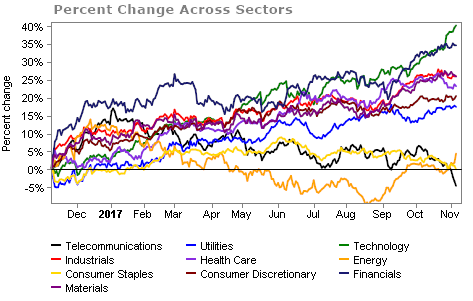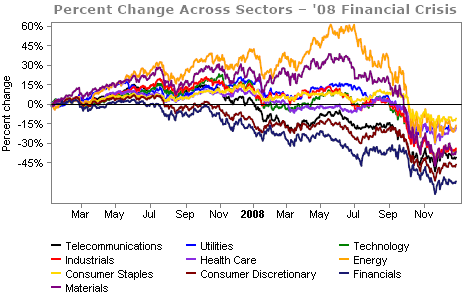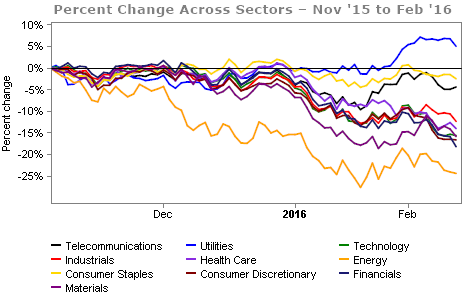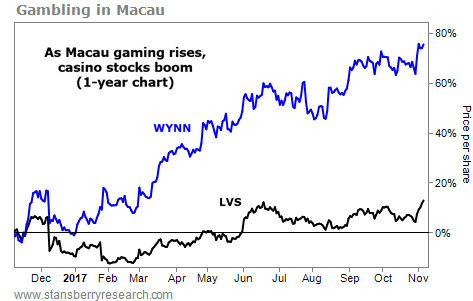| Home | About Us | Resources | Archive | Free Reports | Market Window |
Investment Protection No One Is Talking AboutBy
Wednesday, November 8, 2017
I'll bet you've made this mistake. And I'll also bet that your kids... and grandkids... are making it right now.
I've seen it time and time again. It's one of the quickest ways to lose money in the market.
Just as an example, let's say you put a few hundred bucks into a couple of tech stocks that you think are going to soar. Next thing you know, the tech sector takes a nosedive... And you're left with double-digit losses in a matter of months.
Here's how you can avoid that happening to you...
I've talked before about protecting your portfolio by using trailing stops, position sizing, and owning sleep well at night ("SWAN") stocks. But you could be missing another part of portfolio protection that practically no one is talking about...
This might seem like common sense, but many folks get excited about a certain area of the market and completely forget about the others. If you don't properly diversify your portfolio by owning multiple sectors, you WILL lose money.
Having multiple sectors represented in your portfolio will greatly lower your risk.
In 1999, Standard & Poor's and Morgan Stanley Capital International created a stock classification system. They called this system the "Global Industry Classification Standard." It originally divided the economy into 10 sectors.
Here's a list of the 10 sectors and some popular companies in each sector.
1. Consumer Discretionary: Home Depot (HD), McDonald's (MCD) 2. Consumer Staples: Procter & Gamble (PG), Coca-Cola (KO) 3. Energy: ExxonMobil (XOM), Chevron (CVX) 4. Financials: JPMorgan (JPM), Wells Fargo (WFC) 5. Health Care: Johnson & Johnson (JNJ), Pfizer (PFE) 6. Industrials: General Electric (GE), 3M (MMM) 7. Information Technology: Apple (AAPL), Microsoft (MSFT) 8. Materials: Sherwin-Williams (SHW), Freeport-McMoRan (FCX) 9. Telecommunications Services: AT&T (T), Verizon (VZ) 10. Utilities: Duke Energy (DUK), Southern Company (SO) We all know which sectors are attractive and which ones aren't. Scroll through any financial website and you'll see at least three ads claiming that they have the next "hot tech stock" or the next McDonald's restaurant. The graph below shows how each sector has performed over the past year...
 Energy and consumer staples were flat for the year, while financials and information technology led the way. Those two sectors surged more than 35%... If you invested in companies like JPMorgan and Apple, you've made a lot of money. In fact, if you've invested in just about anything you've made a lot of money in the past several years. Right now, we're currently in the second-longest bull market in history. And if you own the entire S&P 500 Index, the broad market is up an outstanding 16% over the past year.
Currently, stock valuations are high, and many say stocks are overpriced. The average price to earnings (P/E) multiple for the S&P 500 is around 21 today... while the 10-year average P/E is down around 17.
Turn on CNN or any other news channel and you'll hear the bears claiming doomsday is coming.
Now, I don't believe a market crash will happen tomorrow, but a market correction is inevitable. Corrections, which are any 10%-plus declines in the market, are a normal and healthy part of a market cycle.
Diversifying across different sectors will help protect you during market downturns.
Take one of the worst crashes in history as an example – the 2008 financial crisis. As you'll see below, being solely in one sector can ruin a portfolio.
 Financial, consumer discretionary, and telecommunications stocks were the hardest hit during the crisis. Anyone heavily invested in one of these sectors lost 40% to 50% of their portfolio. But if you simply owned a portfolio balanced over all 10 sectors, you could have saved 25%. The financial crisis is an extreme example – it was one of the worst crashes of all time. But the same logic applies to a normal market correction. Let's look over the last "regular" market correction.
 This was during a normal, healthy market correction of 13%. Corrections like this occur often... Excluding the dot-com bust and the 2008 financial crisis, the market has posted a 10%-plus decline 11 times since 1987. The average drawdown was 16.4%. Each correction is different, and it's usually a different sector that incurs the most loss. In this particular correction, energy stocks dipped 20% while utilities went up more than 5%. That's why I always recommend proper asset allocation. If you use this opportunity to diversify not only across asset classes, but sectors as well... your portfolio will thank you.
Good investing,
Dr. David Eifrig
Further Reading:
Asset allocation is a key way to diversify – and it's one of the most important tools you can use to protect your portfolio. Learn how to get started right here: How to Make Your Most Important Wealth Decision in Minutes.
"Investors should not be making huge portfolio moves based on a single prediction," Dave writes. Making big, bold calls won't protect your wealth... But diversification will. Read more here: The Real Key to Building Lasting Wealth in the Market.
Market NotesGAMBLING IN CHINA IS BOOMING Today, we're revisiting China's gambling capital...
Regular readers know Steve has been bullish on the potential in Macau for more than a decade. This tiny, autonomous region is the only place gambling is legal in China. People go there to blow off steam. And the world's premier casino operators have built incredible resorts there that transport their guests to other parts of the world.
Last September, we told readers about the turnaround in gambling revenues in Macau. That trend has continued. Gaming revenues have risen for 15 straight months in the region... And that pickup in gaming is boosting two global gambling leaders – Wynn Resorts (WYNN) and Las Vegas Sands (LVS). The region is vital to Wynn and Las Vegas, who earn about 60% and 37% of their sales, respectively, from their Macau resorts.
As you can see below, both companies are making strides this year thanks to the uptick in gaming. WYNN and LVS shares are up 72% and 15%, respectively, over the past year... And they both recently hit fresh 52-week highs. If China's gambling market stays strong, these rallies are likely to continue...
 |
Recent Articles
|



